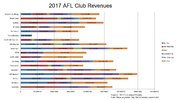Broken
Brownlow Medallist
Just curious from the main thread discussion Jumper clash fails how much do teams benefit from guernsey sales?
To me, struggling teams would benefit from pumping out X amount of designs each season to prop up their financial woes, but I'm wondering how much it would work in the real world.
For instance the Suns, with no tradition, would make a killing from a new design every two years.
To me, struggling teams would benefit from pumping out X amount of designs each season to prop up their financial woes, but I'm wondering how much it would work in the real world.
For instance the Suns, with no tradition, would make a killing from a new design every two years.






